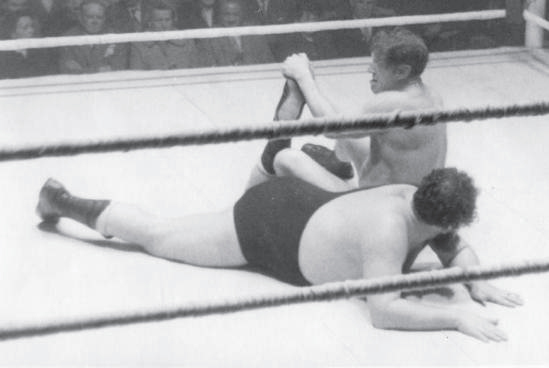Professional wrestling in Great Britain goes back a lot further than you think, with origins in localised wrestling styles in the heart of England.
Wrestling as a sport is arguably the oldest in human history. The act of two men competing physically the out-muscle the other is the simplest, most animalistic form of competition one could conceive.
Wrestling is mentioned in the Bible, the Mahabharata, the epic of Gilgamesh and the Iliad. Some falsely claim that cave paintings in France show wrestling as far back as 15,000 BC, although images of two figures grappling were dated to be from around 7000 years ago.
It is as ancient as humanity itself, which could be why it resonates so much with the population. Over time, rules and regulations were brought in, with money on the line. The first fixed wrestling match was nearly 2000 years ago in Egypt, and it only got worse and more crooked from there.
In Britain, wrestling as a sport was varied. Each region had their own version, with Lancashire wrestling being the one that grew to become the professional wrestling we know today.
Lancashire Wrestling Was The Basis Of Professional Wrestling In Britain

Lancashire Wrestling is a style of wrestling that developed in the Lancashire region of England. It focused on holds and submissions and was deeply tied into the working-class roots of the Lancashire towns.
Its main selling point was a lack of restrictions and an open rulebook. This made it more restrictive, and the fights more entertaining for the viewing public. This is the main reason why Lancashire wrestling grew outwards, becoming popular across the United Kingdom during its peak.
Lancashire wrestling was different to most other styles. While they all shared a broad understanding of what wrestling was, the Lancashire style had no fixed “starting position”.
That meant that the wrestlers could find a way to lock on a hold in any way they could (within the rules, of course). This gave it a more “free-for-all” style, with a rougher, more violent game.
It also allowed holds below the waist, adding another element to the fight, which sports like Cornish wrestling outright banned. This mirrored the local community in Lancashire. The rugged countryside and harsh weather bred tough men, which itself bred a more physical style of wrestling.
While wrestling was done for various reasons throughout history, Lancashire wrestling was viewed as a sporting activity. The competitors, usually miners working in the area during the 1800s, would test their metal in front of crowds occasionally numbering in the 1000s.

They were not professional in these days, although the fights did allow them to make some extra money.
Matches had to be sanctioned by the sporting body, with a referee appointed to take control. Both workers put their own money on the line, with punters not unlikely to have a flutter on who the winner would be.
Former wrestler and trainer Tommy Heyes said in an interview, “A typical Lancashire catch as catch can match would take place when one wrestler challenged another for an agreed sum of money.”
“If this challenge was accepted, then the wrestlers and their backers (people who were prepared to pay a significant amount of money on the outcome) would go to the local office of the Sporting Chronicle (the then governing body of the sport) and sign Articles of Agreement.”
“A referee was then appointed in order to control the match and pay out the stake money to the winner”.
There were rules to the fights, despite its “free-for-all” reputation. Punching was disallowed, although the amount of holds you could inflict on your opponent was not capped. This style of wrestling became known as “Catch-As-Catch-Can” wrestling, which is what British wrestling is sometimes known as today in foreign countries.
The word dates all the way back to the 1300s, although it wasn’t attributed to the Lancashire style of wrestling until professionalism was introduced in the 1820s.
Catch-As-Catch-Can Had Rules Written In 1856

By the 1840s, the sport had become more deadly and violent as the years went on. While punching remained banned, strangulation, eye gouging and biting became commonplace.
This became too much for many, and the sport sought to replace the Lancashire Rules with the Cumberland and Westmorland wrestling ruleset instead.
However, the sport continued to fall in popularity, and something had to be done. In a move that was later mirrored by the death of All-In Wrestling in the 1940s, a new ruleset was created to codify the Catch wrestling style.
These were called the “Snipe Inn Rules” They were named after the Snipe Inn, one of the most important venues in the history of Lancashire wrestling. These Snipe Inn Rules weren’t excessive by any means. They stipulated that wrestlers must only wear “drawers and pumps”, although shoes were later outlawed.
They also banned spikes or nails in the competitor’s shoes. It is bizarre that they were allowed in the first place, so the ban seemed a good idea. Wrestlers were also banned from covering themselves, and it made clear that matches were two out of three pinfalls to win. (You can read the full rules at WrestlingHeritage)
Catch Wrestling Dominated Britain, Even Spreading To London
By the late 1800s, this new Catch wrestling had made its way around the country. Wigan became the new hub for the sport, with numerous champions coming from the region. Meanwhile, the country’s capital held a huge tournament in 1899, as Lancashire wrestling took over London.
During the Easter Holidays in 1899, an open-to-all-men tournament was held at the National Athletic Grounds, in Kensal Rise, London. Two weight divisions – middleweight (12st limit) and lightweight (10st 4lb limit) – were created, although only a middleweight champion would be crowned.
Hindley-born Joe Carroll won the tournament, becoming the first official “British Wrestling Champion”. The popularity of the event led to Tom Cannon to create the first Catch wrestling promotion that very same year.

The scene went through a boom period in the early 1900s, when Catch-As-Catch-Can wrestling turned professional. There was a boom period in the first decade of the century, before falling out of favour over the coming years.
Billy Riley became another huge name in the Catch wrestling scene. He helped keep the Lancashire Style alive into the 1930s, defending his World Championship against the German Karl Reginski.
The match took place in Wigan, and saw the experienced Briton defend his countries. Billy Riley went on to found “The Snake Pit”, arguably the most influential wrestling gym in British wrestling history.
Jack Carkeek Helped Turn Catch Wrestling Into Sports Entertainment

While Catch Wrestling became the most popular form of grappling, it was a Cornish wrestler who helped make wrestling into what it is today. American-Cornish wrestler Jack Carkeek helped wrestling move away from being purely a sport, and more towards the sports-entertainment business.
Or course, “Sports Entertainment” is a term coined by Vince McMahon, of the WWE. He used it to differentiate his product from real sports, to avoid the regulations that came from being seen as “real”.
In this instance, we’re using it to mark the move from a pure sporting contest to an entertainment product, or “music hall act”. Jack Carkeek performed during strongman acts in music halls. The American would challenge people from the crowd to try and last ten minutes with him in a wrestling match.
Naturally, his experience and strength made light work of the (often drunk) paying customers. However, just to make sure, they’d often use plants in the audience to lose on purpose, to make Carkeek look even more impressive.
William Regal got into the wrestling business doing this exact thing on Blackpool beach in the 1970s. Jack Carkeek became a huge star doing this. That was until he came face to face with Georg Hackenschmidt.
Carkeek refused to wrestle Hackenschmidt, and his career quickly faded. The Estonian, who was billed as “The Russian Lion”, beat all his challengers in the UK, becoming a huge star.
However, he left for the US soon after, along with all the top foreign draws. This left British wrestling in a state of disrepute, before the outbreak of the First World War stopped it completely.
All-In Wrestling would dominate the country in the 1930s, before it was banned in London completely. This was eventually replaced by the Lord Mountevans rules which completely redefined what wrestling was in Britain.

